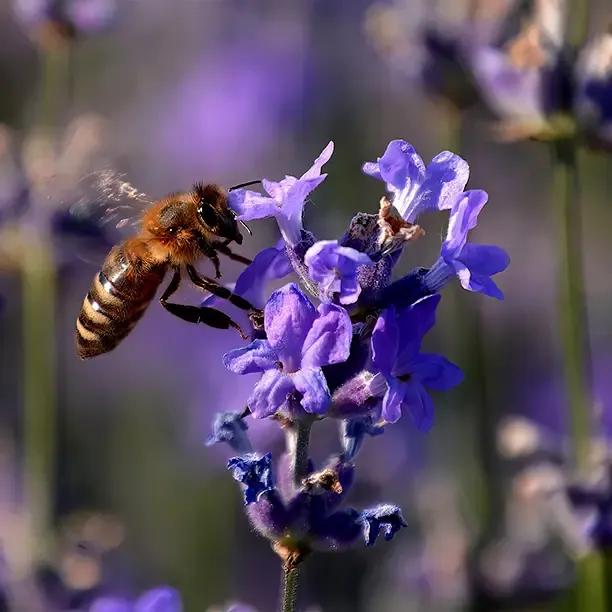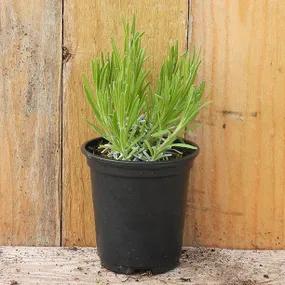Beezee Dark Blue Lavender Plants
Honest Delivery PricesMost Popular Mini-English Lavender
- Use: Low hedging / edging, ideal for containers
- Flowers: Spikes of rich purple-blue
- Flowering: June/July to September
- Scent: Strong, lavender
- Leaves: Evergreen, aromatic. Silvery when mature
- Height x Spread: 40cm x 40cm
- Unappealing to deer, rodents
- Drought tolerant when established
- Culinary herb
- RHS Plants for Pollinators
Recommended extras
Description
Lavandula angustifolia 'Beezee Dark Blue': Dwarf Purple English Lavender Plants
Beezee Dark Blue is a superb dwarf lavender ideal for really low front of border edging, and containers.
The flowers are deep Hidcote-purple with similar bushy, grey-silver foliage to under 40cm.
Lavender is already a fab patio plant - it's the right size and loves the drainage of pots.
Being so compact, Beezee Dark Blue is the go-to lavender for large container designs where you want the hedge effect of lavender in rows, but suited to the scale of your container.
Other lavender varieties are often used that way for one-year designs, but if you want to keep it in place and clip it yearly then Beezee Dark Blue works very well around the edge of big pots, troughs, etc!
Lavenders are all irresistible to bees and butterflies, and L. angustifolia cultivars in particular are useful edible herbs, so they deserve a place among working fruit and veg plots.
It retains its scent wonderfully all summer and then in its dried flowers.
Browse our varieties of lavender, other evergreen hedging, or all hedging plants.
Delivery season is weather dependent. There is no point planting lavender out before nighttime temperatures rise as the shock sets it back, so it establishes slower than lavender planted later when the soil is warm.
- The smallest lavenders, in P9 pots, are never shipped before May.
- We aim to ship the larger pot sizes from the end of April, but cold weather can delay delivery into May.
Features
- Most Popular Mini-English Lavender
- Use: Low hedging / edging, ideal for containers
- Flowers: Spikes of rich purple-blue
- Flowering: June/July to September
- Scent: Strong, lavender
- Leaves: Evergreen, aromatic. Silvery when mature
- Height x Spread: 40cm x 40cm
- Unappealing to deer, rodents
- Drought tolerant when established
- Culinary herb
- RHS Plants for Pollinators
Growing Beezee Dark Blue Lavender
- Aspect: Full sun, South facing
- Soil: Well drained is vital, poorly fertile is preferable
- Soil pH: Above 6.5 is best. Likes chalk
- Hardiness Rating: H5 (to -15C)
- Suitable for the coast and windy locations
- Ideal for container growing
Lavender must have good drainage and close to full sun. It prefers poor soil and thrives in exposed coastal sites.
When established, they are drought-tolerant, but in their first and second year you must water them well, as with any new shrub.
Don't plant lavender out too early in Spring: the cold soil will shock it and set it back. In most years, this means waiting until May.
Spacing a Beezee Dark Blue Lavender hedge: Being a dwarf variety, you can squeeze it closer at 4 per metre, 25cm apart in a single row, which will knit together quickly.
There are different approaches to pruning, which is necessary to keep your lavender dense and beautiful.
The essential thing is to cut all the new, green growth down to two or three buds typically in early September, around when the last flowers have faded.
A light tidying trim in Spring is optional, but recommended.
Deer and rodents are not interested in lavender - they might nibble fresh green Spring growth to test it, but as the foliage matures they ignore it.
In Your Garden Design
The pale, silvery, evergreen foliage reflects the light joyously throughout the year. With the flowers, they add structure to the front of a herbaceous bed, softening the boundary with a lawn or path, and it can be clipped beautifully into simple geometric shapes.
Beezee Dark Blue's violet goes well with pink roses like Nathalie Nypels.
In a potager, Beezee Dark Blue makes a welcome change from Box (Buxus sempervirens) when used as elegant, dark flowered edging for a bed full of herbs, which often have purple flowers themselves.
Did You Know?
This variety is unofficially nicknamed "mini-Hidcote" - Hidcote being the bestselling English Lavender - and it deserves the praise! It has that rich blue-purple colour, and does a good job of maintaining the flower density despite the large reduction in size.
Planting Instructions
Read our full guide on how to grow lavender, with a quick pruning video.
- Good drainage is most important: Lavender tolerates cold weather, but it hates "wet feet" in winter.
- Heavy clay on a dry, sunny hill that sheds water should be fine, but light, dry, poorly fertile soils are ideal.
- If your site is not well drained, lavender thrives in pots.
- It needs plenty of sun to flower well.
- It can grow near the sea, good for windy sites.
- It's drought resistant after it has established deep roots, which takes a couple of years.
Prepare the Soil Before Planting
- The key is to remove weeds and to break up soil compaction, so the new roots can spread out rapidly downwards and sideways.
- Don't enrich the soil, only use Rootgrow mycorrhizae at planting time.
- To improve drainage, it helps to raise the soil level a little by forking in plenty of grit and sharp sand, however, this is not usually practical beyond a small ridge or mound: growing Lavender in a pot is much easier than raising the level of a whole bed!
Care for Your New Lavender Hedge
- Most important: water thoroughly in dry weather for the first growing season. Soak the ground, and then let the soil almost dry out before watering again.
- Second most important: weed around the plants.
After the first growing season, lavender in most gardens should never need watering again.
If your soil is very dry and sandy, then continue to water in dry weather at the start of their second growing season.
Even with the best care, all lavender hedging tends to go woody and floppy after 10-15 years, losing its full appeal. When you see this happening, take cuttings to replace the old hedge, or order new ones from us.
Trimming Lavender Plants
A hard trim every year in late autumn ensures dense growth, more flowers, and extends Lavender's ornamental life span.
Cut back each stem to about two buds / 2cm of green growth.
- Avoid cutting into the older, woody part of the stems: if you prune yearly, you should never need to do this.
Deadhead flowers regularly to encourage more - it's up to you to decide whether to leave the last blooms on the plants overwinter.
Hygiene & Diseases
Lavender is very disease resistant, and diseases are typically indicators that the site is too damp and/or shady for Lavender to thrive.
- Prune off Dead, Damaged or Diseased (DDD) wood as soon as it appears.
- Disinfect your pruning tools between every cut if there are signs of disease.
- Disposing of diseased material is safer than composting it.
- Clean out Autumn leaves from underneath your plants, which can trap damp.



